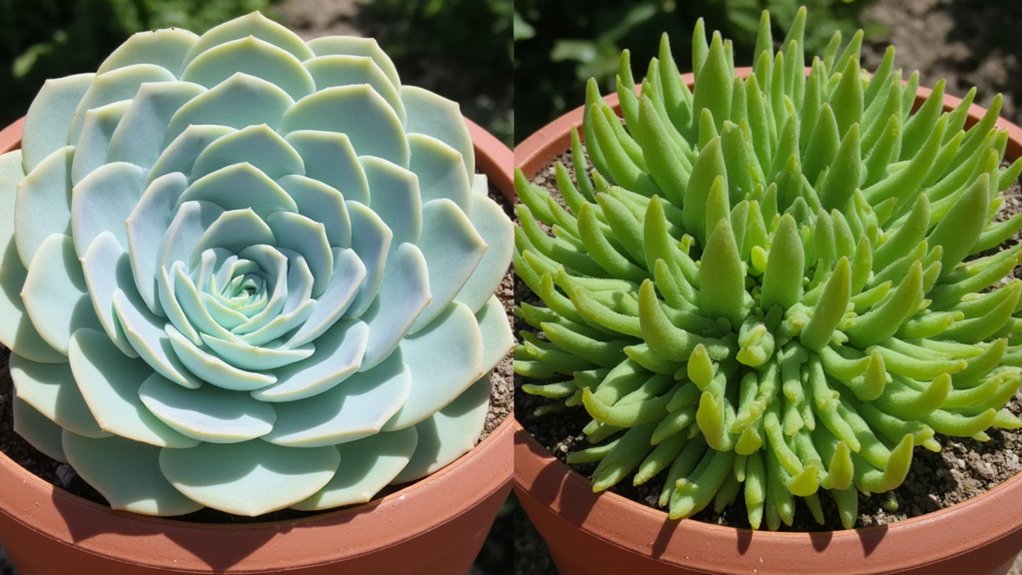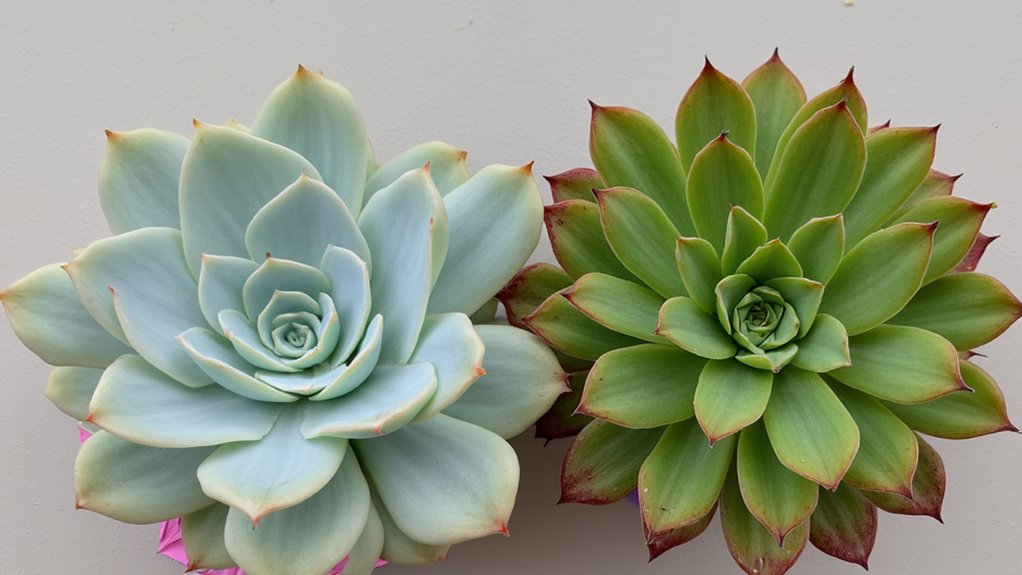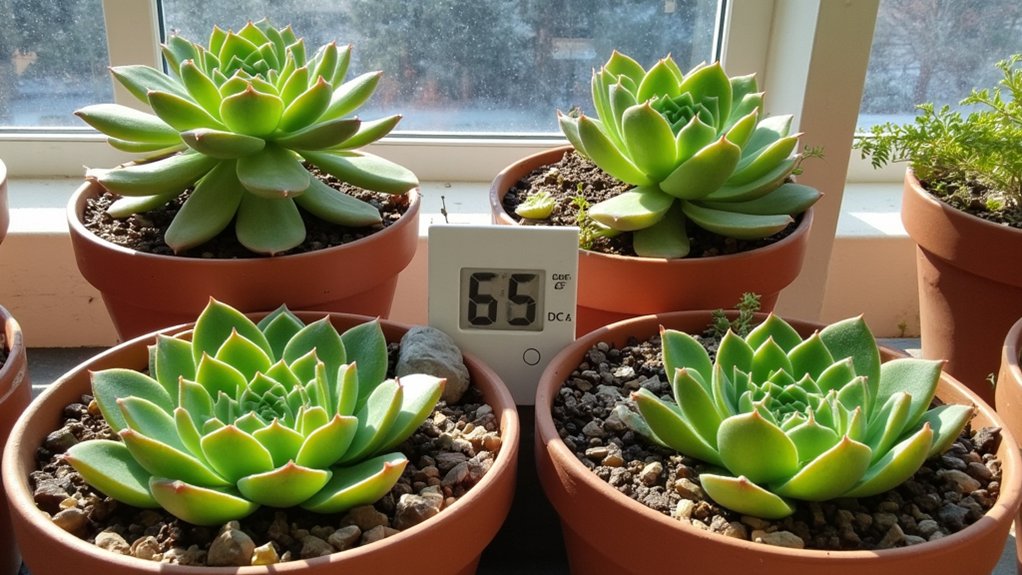If you’re torn between growing Echeveria or Sempervivum, you’re facing a classic succulent dilemma. While both plants feature stunning rosette formations, they couldn’t be more different in their care requirements and growing preferences. Your success with either variety will largely depend on your local climate, available growing space, and willingness to adapt to each plant’s specific needs. Let’s explore which of these beauties might be your perfect match.
Contents
- 1 Understanding the Origins of These Popular Rosette Succulents
- 2 Key Visual Differences Between Echeveria and Sempervivum
- 3 Temperature and Climate Requirements for Both Plants
- 4 Indoor vs. Outdoor Growing Success Rates
- 5 Watering and Soil Needs: A Side-by-Side Comparison
- 6 Propagation Methods and Growth Patterns
- 7 Common Problems and Solutions for Each Variety
Understanding the Origins of These Popular Rosette Succulents

While both Echeveria and Sempervivum display stunning rosette formations, these succulents come from vastly different corners of the world. You’ll find Echeveria species naturally growing throughout Mexico and Central America’s semi-desert regions, where they thrive in bright, warm conditions at elevations between 500-3,000 meters.
In contrast, Sempervivum, often called “hens and chicks,” originated in Europe’s mountainous regions, particularly the Alps and Carpathians. They’ve adapted to survive harsh winters and can withstand temperatures as low as -30°F (-34°C), making them incredibly hardy compared to their tropical Echeveria cousins.
Key Visual Differences Between Echeveria and Sempervivum

These two hardy succulents may share similar origins in rocky terrain, but they’ve developed distinct visual characteristics that make identification straightforward once you know what to look for. Echeveria typically displays smooth, waxy leaves in muted blue-green to pink hues, while Sempervivum features textured, pointed leaves in deeper greens and reds.
You’ll notice Echeveria rosettes grow larger, often reaching 6-12 inches in diameter, with leaves that curve upward at the tips. Sempervivum remains more compact, usually 3-6 inches across, with tighter rosettes and leaves that lay flatter against each other, creating a more geometric pattern.
Temperature and Climate Requirements for Both Plants

Despite their similar appearances, Echeveria and Sempervivum have strikingly different temperature tolerances that affect where you can grow them successfully.
Echeveria thrives in warmer climates between 65-80°F (18-27°C) and can’t survive freezing temperatures. You’ll need to bring these tender succulents indoors when temperatures drop below 50°F (10°C).
Sempervivum, also known as “hens and chicks,” are cold-hardy champions that can withstand temperatures as low as -30°F (-34°C). They actually need a cold period to thrive and will struggle in consistently hot climates above 85°F (29°C).
For year-round outdoor growing, match your climate zone to the right plant: Echeveria for zones 9-11, Sempervivum for zones 3-8.
Indoor vs. Outdoor Growing Success Rates
Understanding where your succulents will thrive can make all the difference in their survival rates. Echeveria shows an 80% success rate indoors with proper lighting, while only 40% typically survive long-term outdoor exposure in zones below 9. They’ll flourish under grow lights or in bright windowsills.
Sempervivum, conversely, reaches 90% survival rates outdoors in zones 3-8, but only 30% thrive as houseplants. You’ll find they’re practically indestructible in rock gardens and ground cover applications, where they’ll multiply readily. Even in subfreezing temperatures, they’ll maintain their vigor when planted in well-draining outdoor locations.
Watering and Soil Needs: A Side-by-Side Comparison
While both succulents need well-draining soil, Echeveria and Sempervivum have distinct watering requirements that’ll impact their survival. You’ll want to water Echeveria every 7-10 days during growing season, letting the soil dry completely between waterings. For soil, mix 50% cactus mix with 50% perlite or pumice.
Sempervivum, being more drought-tolerant, only needs water every 14-21 days, even in summer. They’ll thrive in lean, rocky soil with just 30% organic matter. If you’re growing them outdoors, natural rainfall might be enough in many climates, though you’ll need to guarantee excellent drainage.
Propagation Methods and Growth Patterns
Both Echeveria and Sempervivum offer multiple propagation methods, though they’ll grow quite differently. You can propagate Echeveria through leaf cuttings, stem cuttings, and offsets, while Sempervivum primarily reproduces through “chicks” that emerge from the mother plant.
Your Echeveria leaves will take 2-3 weeks to sprout roots when placed on well-draining soil, and new rosettes form in 4-6 weeks. Sempervivum’s chicks, however, develop naturally throughout the growing season and can be separated once they’re quarter-sized.
Echeveria grows as individual rosettes that expand outward, while Sempervivum forms tight clusters that spread like a living carpet.
Common Problems and Solutions for Each Variety
Despite their hardy nature, Echeveria and Sempervivum each face distinct challenges that can affect their health and appearance. While Echeveria struggles with overwatering, root rot, and etiolation from insufficient light, Sempervivum battles crown rot, winter damage, and seasonal color changes.
You’ll spot Echeveria problems when leaves turn yellow or translucent. Combat these issues by reducing watering frequency and moving plants to brighter locations. For Sempervivum, inspect the center rosette regularly for signs of rot, and remove affected plants immediately.
Both varieties can develop mealybugs. Treat infestations with 70% isopropyl alcohol applied directly to these cotton-like pests using a cotton swab.
